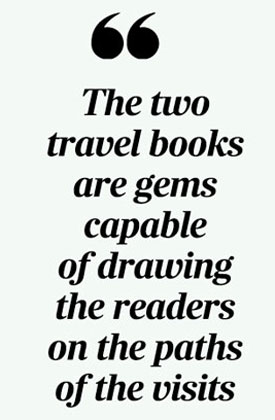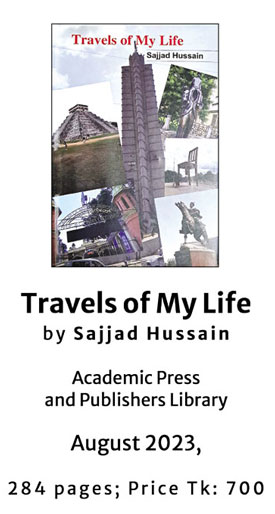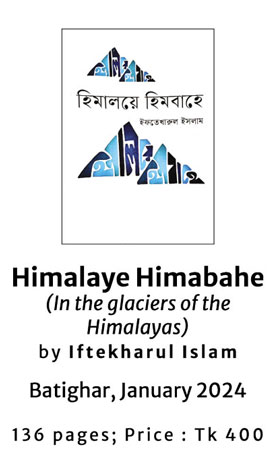 Two travel books, one in English titled Travels of My Life by Sajjad Hussain and the other in Bengali named Himalaye Himabahe (In the glaciers of the Himalayas) by Iftekharul Islam came to my hand very recently and must be recommended as gems that would draw readers again and again and would put them on the paths of the visits.
Two travel books, one in English titled Travels of My Life by Sajjad Hussain and the other in Bengali named Himalaye Himabahe (In the glaciers of the Himalayas) by Iftekharul Islam came to my hand very recently and must be recommended as gems that would draw readers again and again and would put them on the paths of the visits.
Hussain’s book covers thirty chapters and nearly thirty countries and cities, not surprisingly starting with his sojourns in boyhood days with parents on the move in transferable jobs. The one from Sylhet to Dinajpur in a reserved train saloon car that used to be detached and reattached on the way is interesting reading and history reevoking. His visit to Comilla and to the hills in Chittagong in his teens along with friends appears to be adventurous and daredevil. As these lines are being written about his book, Mr Hussain, like an addict, has just completed a visit to Peru, seeing the wonders of Machu Picchu. So, it is not surprising that the book starts with these words: “I have been a travel buff from my youth.” While he is a retired Member of the National Board of Revenue having to visit many countries on government duty and training, his wife had been a Dhaka University teacher having ‘plenty of freedom and opportunities to travel’. In most places Hussain would take his spouse.
 Of the dozens of countries he toured, Andaman Islands in the Bay of Bengal and Cuba in the far west of the globe appear to be exhilarating and ample. We come to know first-hand about the Cuba’s economy, health system and education. The question may be asked as to how many Bangladeshis have gone there. Definitely not many. Then there is a good piece on Kerala, ‘God’s Own Country ‘ as they call it. One feels that Mr Hussain is taking his readers along with him as they read about the backwaters, boat journeys and the local food. He has gone to Indian Kashmir, to Sikkim for a taste of the Himalayas, to Darjeeling and its tea hills to reminisce his pre-government job in the tea gardens of Bangladesh. He has visited four countries of Scandinavia and three countries of central Europe, to Russia to see how the post-Soviet system works. Mexico seems to be a far-off country for most Bengalis, and he has had an enjoyable trip there too. One would envy him for the comprehensive hotel and hospitality on offer at Can Cun, on the Gulf of Mexico. Mr Hussain has travelled the length and breadth of the USA and Canada. On a trans-Canadian train journey from Toronto, he went up to the shores of the Pacific off Vancouver and Victoria BC, where he saw first-hand the movement of the great whales of that great ocean.
Of the dozens of countries he toured, Andaman Islands in the Bay of Bengal and Cuba in the far west of the globe appear to be exhilarating and ample. We come to know first-hand about the Cuba’s economy, health system and education. The question may be asked as to how many Bangladeshis have gone there. Definitely not many. Then there is a good piece on Kerala, ‘God’s Own Country ‘ as they call it. One feels that Mr Hussain is taking his readers along with him as they read about the backwaters, boat journeys and the local food. He has gone to Indian Kashmir, to Sikkim for a taste of the Himalayas, to Darjeeling and its tea hills to reminisce his pre-government job in the tea gardens of Bangladesh. He has visited four countries of Scandinavia and three countries of central Europe, to Russia to see how the post-Soviet system works. Mexico seems to be a far-off country for most Bengalis, and he has had an enjoyable trip there too. One would envy him for the comprehensive hotel and hospitality on offer at Can Cun, on the Gulf of Mexico. Mr Hussain has travelled the length and breadth of the USA and Canada. On a trans-Canadian train journey from Toronto, he went up to the shores of the Pacific off Vancouver and Victoria BC, where he saw first-hand the movement of the great whales of that great ocean.
Not many Bangladeshis now-a- days think of the Andaman Islands. Mr Hussain and a friend organised a private trip to Port Blair and adjoining areas, while on a visit to West Bengal. He has named this chapter a ‘sentimental journey’, no doubt due to the attachment of Netaji’s Azad Hind Fouz to it. He ends the chapter with these words: “He (Subhash Chandra Bose) became President of Congress, but his kind of leadership was too much of a threat for the entrenched leadership. Leaders like Gandhi, Nehru forced him out of office.—I would venture a guess that had he been the Congress leader the political map of post 1947 India would probably be different.” A historian’s conclusion indeed.
 On his taxation training course, he journeyed to Japan and saw Mount Fuji and atomic bomb-devastated Hiroshima. In his NDC training in Dhaka, two foreign tours were attached, one to India and the other to the UK. He went to the Scottish countryside and had to swallow not so good a food item called ‘Haggis’, termed the national dish of the Scots, that had to be forced in with the help of drinks. His book also includes visits to Nilgiri and the Sundarbans inside Bangladesh. His two daughters and a son had their higher education outside the country, in Canada and the USA, a fact that drew the couple more to those countries. It is no wonder that the two of them fell in love with Canada. The book fittingly ends with a chapter on their ceremonial acceptance of Canadian citizenship.
On his taxation training course, he journeyed to Japan and saw Mount Fuji and atomic bomb-devastated Hiroshima. In his NDC training in Dhaka, two foreign tours were attached, one to India and the other to the UK. He went to the Scottish countryside and had to swallow not so good a food item called ‘Haggis’, termed the national dish of the Scots, that had to be forced in with the help of drinks. His book also includes visits to Nilgiri and the Sundarbans inside Bangladesh. His two daughters and a son had their higher education outside the country, in Canada and the USA, a fact that drew the couple more to those countries. It is no wonder that the two of them fell in love with Canada. The book fittingly ends with a chapter on their ceremonial acceptance of Canadian citizenship.
The other travelogue that I read together with Sajjad Husain’s book was by Iftekharul Islam titled ‘Himalayer Himabahe’, the Bengali name can be translated to ‘In the glaciers of the Himalayas’. Iftekharul Islam’s Bengali book on treks to the Himalayas belongs to a different genre of travelogue. This is his second book on the Himalayas, the first one being ‘Jekhane Everest’ (where the Everest is).
A pharmacist and business-masters by education, Mr Islam has served multinational companies in Bangladesh and in India. However, his passion has been the Everest and the Himalayas. Although age prevented him from aiming for the biggest prize, getting to the highest peak of the world, the Everest Base Camp (EBC) at 17,598 feet is extraordinary for a person in his post sixties. He has been to the Everest areas thrice, including once after the publication of this book earlier this year; and to the Annapurna Base Camp once. The hair-raising experience of helicopter journey inside the valleys and the peaks (from Katmandu to Pokhra), negotiating ridges and brooklets on foot are all enchanting and jaw-dropping to read and know. The writer describes his unique experiences in short sentences of honeyed language, like Mr Hussain’s English. Every aspect of a mountaineering experience is detailed. He reminds us of Rhododendron flowers in the Himalayas, an item of nature that most Bengalis learnt through Tagore. In the end, besides its literary flavour, it has become a very useful guidebook for future venturers. One may specially look after the pages 41-42 of the book, which gives a vivid routine of his journey to the Gokyo Ri, a peak at 17,575 feet, from where four 8000-metre plus mountains of the range including the Everest are stunningly visible. Mr Iftelharul Islam is one adventurer of whom every Bengali can be proud.
His love affair with the Himalayas is described on the first two pages of the book: from Ama Dablam View Lodge and restaurant, on a glittering sunny day he had a fascinating view of the Ama Dablam Peak( 22,349 feet). He says he did not want to move from there: “ I fell in love with the Himalayas right in this place in the year 2020.” That was just before when corona pandemic had swamped the world.
While Mr Husain is a globe-trotter, Mr Islam is an avid lover of the Himalayas; his third trip to trek the world’s highest mountains up to the EBC in post-sixty years of life is tantamount to prove how deeply he is glued to the range. The photos placed inside the book give one the amazing sight of snow-capped peaks, some taking on the golden hue in the morning hours.
If one opens pages of the book, one would find in a summary of what Mr Islam has done over the weeks spent in the mountains. As told earlier, it not only gives guidelines for future trekkers, but also for readers in a hurry, we get summary of what a trekker does. Indeed, spending weeks in the Himalayas, either at a base camp, or the top of the high or next-to- high peaks, The path despite its adventures is full of excitement and drama and dangers. Once Islam was narrowly saved from a falling stone. As this was his second visit for the EBC, he came across a number of acquaintances, including helpers and path-finders, of whom Nepal has created quite a thriving tourist industry. As Islam tells us, they are smart and punctual and over years, they have acquired expertise hardly anywhere to be found in the mountain ranges. He also went to the Annapurna Base Camp (ABC), his first. As we read this book through Islam’s beautiful language, we feel sad that it is ending; and what he says at the very end really touches the heart: “The world is beautiful because the Himalayas are there.”
akhtarhk@gmail.com
© 2025 - All Rights with The Financial Express
